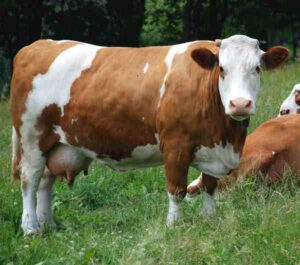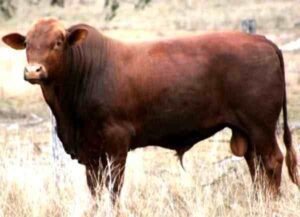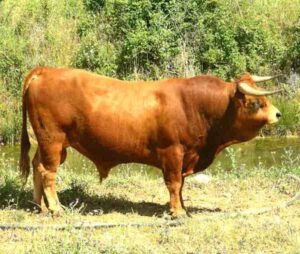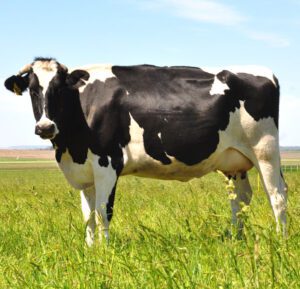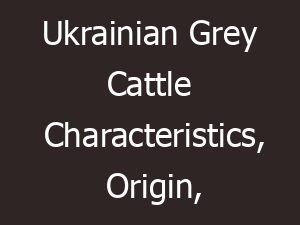The Dutch Belted cattle (also known as Lakenvelder) are a dairy cattle breed which are raised primarily for milk production and also good for the production of meat.
It is the only belted cattle breed (according to records) tracing back directly to the original belted or ‘canvassed’ cattle which were described in Austria and Switzerland.
The original belted cattle were originated in Switzerland and Austria. And the ancestors of the Dutch Belted cattle breed were moved to the Netherlands by Dutch nobility by the 17th century.
And the nobility who owned these cows are also claimed to have bred the belted color pattern into other livestock, including Hampshire pigs, Dutch rabbits, and Lakenvelder chickens. The belted color pattern was highly desirable in the Netherlands.
In the 1830s, the Dutch Belted cattle breed was first imported into the United States. There the breed was exhibited as a rare breed of cattle by P.T. Barnum in his traveling circus.
The Dutch Belted Cattle Association of America herdbook was established in 1886. The Association still continues today as the oldest continual registry for the breed worldwide.
And the breed became well established in the United States and continued in popularity until about 1940. But total number of the animals declined worldwide to the point of near-extinction during the 1900s.
Currently the Dutch Belted cattle are listed as ‘critical’ by the American Livestock Breeds Conservancy on the Conservation Priority list.
Today total population of the breed is estimated at less than 300 in the United States and fewer than 1000 worldwide. Read more information about the breed below.
Dutch Belted Cattle Characteristics
The Dutch Belted cattle are medium sized animals with belted color pattern. They have base color of either black or dusky red. The black base color is most common.
And the most distinguishing characteristic of the breed is the wide belt of white around it’s middle, placed between the shoulders and the hips.
Naturally both bulls and cows have horns, and their horns are long and curved slightly upward at the points.
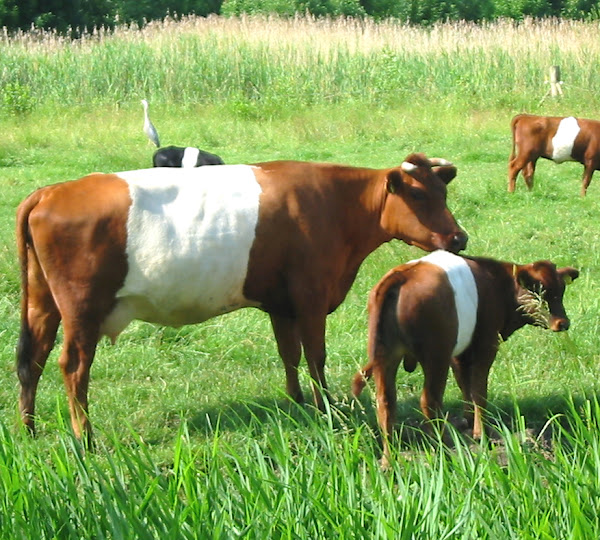
Their head is broad but comparatively long and somewhat dished. Their bodies reflect the classic triple wedge shape of the dairy cattle, with a straight top line, long wide rump, deep middle and good spring of rib.
Average live body weight of the mature bulls vary from 410 to 680 kg. And the bulls are much larger than the cows. Average live body weight of the mature bulls is around 910 kg. Photo and info from Wikipedia.
Uses
Dutch Belted cattle are mainly a dairy cattle breed. They are raised mainly for milk production. But the breed is also pretty good for meat production.
Special Notes
The Dutch Belted cattle are great foragers. They have greater efficiency on grass and forage than the average cattle breeds. In most cases intensive management practices are not required.
The cows are very good milk producers. On average the cows can produce about 9,000 kg of milk per lactation with some cows less or some cows more.
Milk of the Dutch Belted cows is of good quality with naturally very small fat globules and the milk is easily digested. Butterfat content in the milk vary from 3.5 to 5.5 percent.
The breed is also pretty good for meat production. However, review full breed profile of the Dutch Belted cattle in the following chart.
| Breed Name | Dutch Belted | |
| Other Name | Lakenvelder | |
| Breed Purpose | Mainly milk, also meat | |
| Special Notes | Good milk quality, docile temperament, relatively calm behavior, well adapted to native climates, good for meat | |
| Breed Size | Medium | |
| Bulls | Around 910 kg | |
| Cows | Vary from 410 to 680 kg | |
| Climate Tolerance | Native climates | |
| Coat Color | They have a base color of either black or a dusky red with the wide belt of white around their middle, placed between the shoulders and the hips. | |
| Horned | Yes | |
| Milk Yield | Excellent | |
| Rarity | Rare | |
| Country/Place of Origin | Netherlands |

